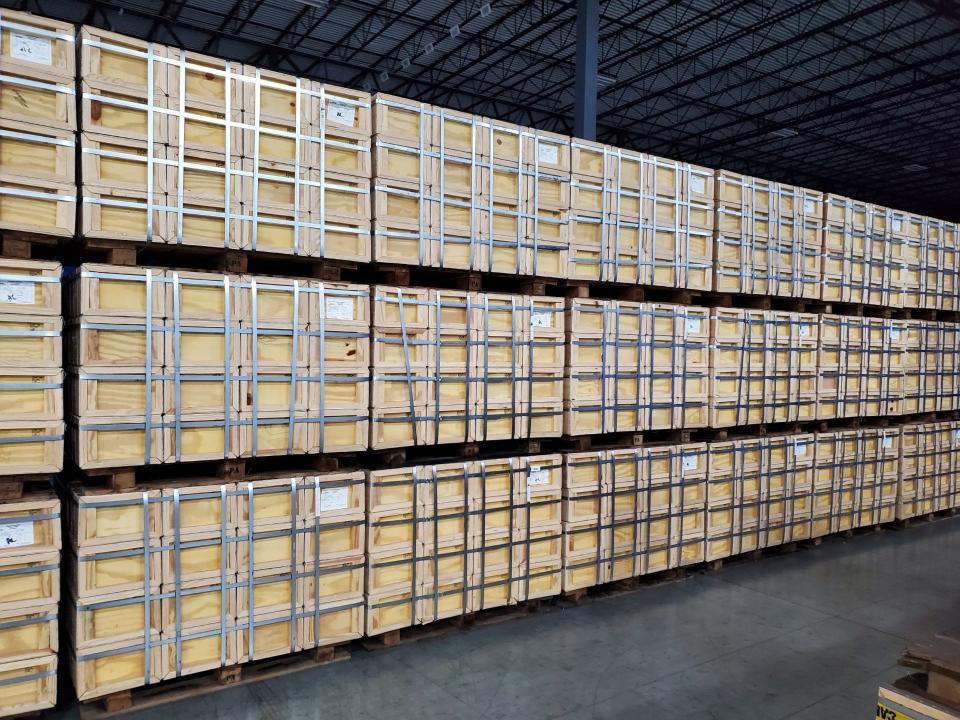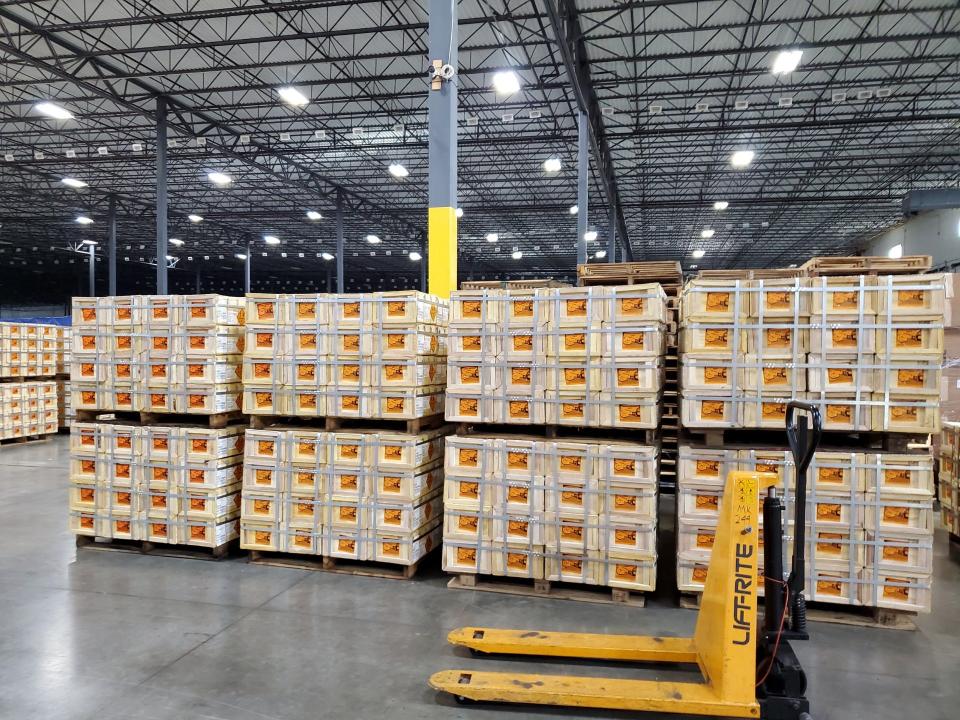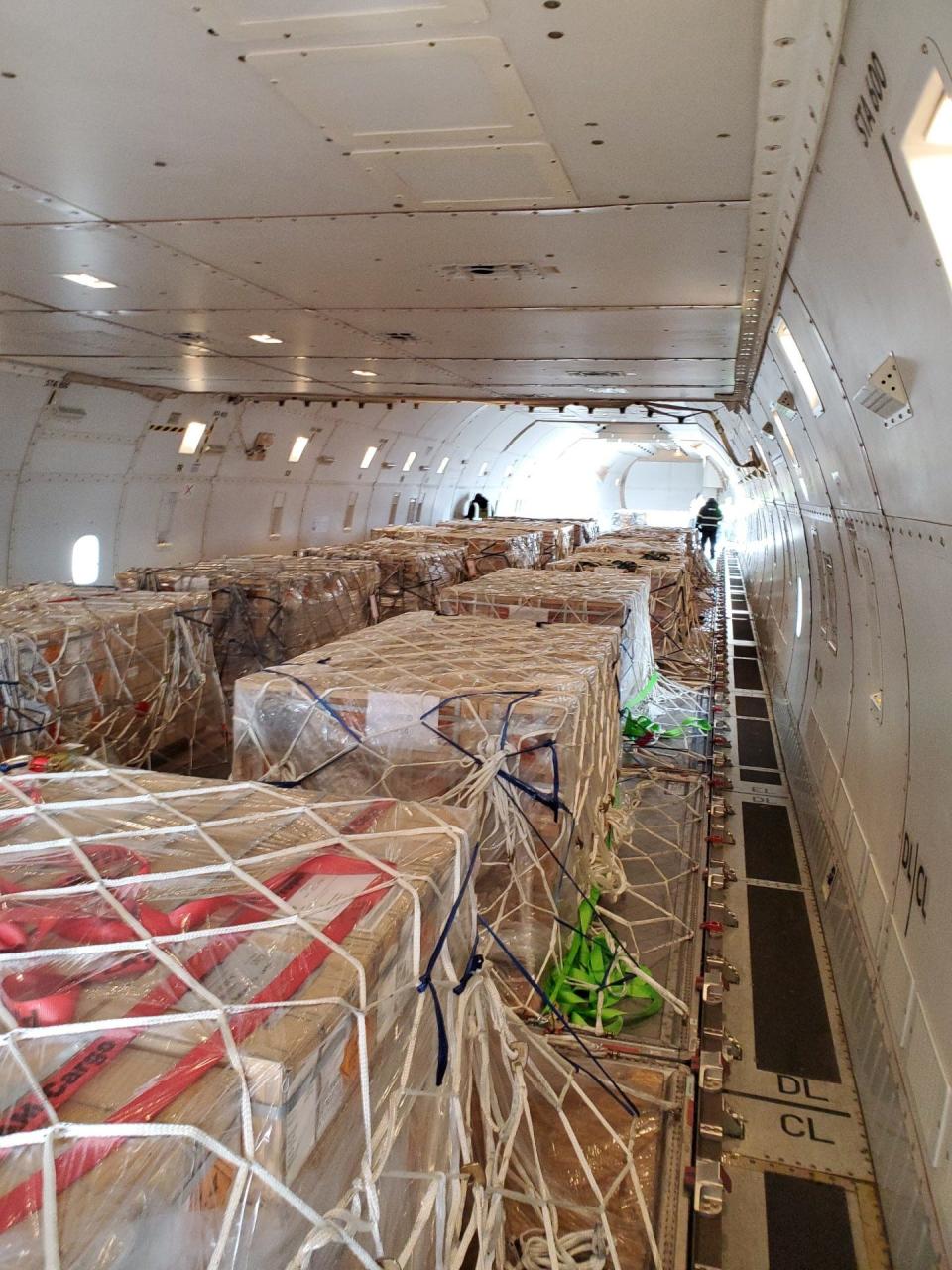Behind the scenes: See how private ammo sales from US are fueling the war in Ukraine

The bullets came in plywood crates.
Any given box was about the size of a small microwave oven. The printed label stuck to each one demonstrated a militaristic brevity. “CARTRIDGES FOR WEAPONS, INERT PROJECTILE,” next to a bright yellow hazmat sticker, “EXPLOSIVES.”
Inside the boxes: drab green steel cans of .50-caliber ammunition. Each round was giant, more than 5 inches long, built to be fired from a gun so big it is typically bolted to a truck. The bullets were clipped together in long strands for rapid, machine-gun fire.
By the time Bill Brown got to the boxes, they sat double-stacked eight high atop wooden pallets inside a Missouri warehouse. The pallets went on, row after row. Three million bullets in all.
It was enough ammunition to feed a single machine gun – if fired nonstop at its rated speed eight hours a day, seven days a week – for almost six months.
Brown’s job was to get it out of there and toward the Ukrainian front lines. The faster, the better.
“War is bad,” Brown said. “Loss of life is bad. But at the end of the day, it’s very profitable and injects revenue into this military industrial base.”

There would be virtually no public record of this Ukrainian arms shipment. As a weapons dealer, Brown’s company would deliver the bullets under a system known as a direct commercial sale. The ammunition required a State Department signoff – but the secret deal would never appear in a White House announcement or the Congressional Record.
Instead, it was part of a shadowy system of brokers, exporters, arms dealers and country-to-country transfers that has become one part of the race to meet demand on distant battlefields.
Western weaponry fueled Ukraine’s summertime counteroffensive along a 600-mile front. President Volodymyr Zelenskyy said the effort was delayed in part by the wait for more arms. Amid concerns about that slowly progessing counteroffensive, Secretary of State Antony Blinken arrived in Kyiv on Wednesday with a promise of up to $175 million more in military equipment.
Most of America’s $44 billion in documented support to Ukraine came in the form of old U.S. military stock, donated directly by the federal government. In general, commercial sales over $14 million, and sales of military-grade weaponry like mortars or missiles, require State Department approval and congressional notification.
But other aid comes via private sales.
More than 14,000 U.S. entities are registered to conduct defense trade activities. Their deals are monitored by an alphabet soup of agencies including Departments of Homeland Security, Commerce, Defense and the Bureau of Alcohol Tobacco, Firearms and Explosives. Trade secrecy clauses in federal law mean this flow of gear, weapons and ammunition is almost never revealed to the public.
Brown, who works for a small Nevada-based logistics company called Battle Born Munitions, provided USA TODAY with a rare look behind the curtain of these private sales. Details about the shipment were verified by his employer and the European government that made the purchase. State Department officials declined to answer questions about the specific shipment Brown described.
This March sale and the secret number of other shipments like it fuel Ukraine’s fight against a Russian invasion. Those sales also release an unknown amount of weaponry into the world. What becomes of that weaponry after it’s sold – and especially after it’s delivered – is difficult to track.
As Brown surveyed the warehouse in Missouri, a crew steered forklifts and skid lifts among the stacks of plain wooden boxes. From high in the trusses, suspended lamp fixtures bathed the boxes in artificial daylight. Brown lifted his camera and started snapping photos.
In just a few hours, he and his cargo would be boarding a jumbo jet. Three million bullets would climb to the stratosphere and hurtle across the north Atlantic toward a European dawn.
From Ukraine: War crimes in Ukraine may be unprecedented. So is the country's push for swift justice.

Chapter 1: The bullets
The bullets had once been bound for Saudi Arabia.
Lot number SMQ19K401L026 had rolled off the assembly line in 2019 at Lake City Army Ammunition Plant near Kansas City. Lake City, owned by the government and run by a contractor, sprawls across nearly 4,000 acres of green Missouri farmland. Roads curve past World War II-era bunkers known as igloos, spaced out amid the countryside – far enough apart that an explosion in one won’t trigger a chain reaction in the others.
Lake City has been pumping out ammunition almost without pause since 1941. It is the largest small-arms manufacturing plant in the world.
Today the plant is run by Olin-Winchester, but in 2019, the bullets were made by some of the 1,700 workers employed by Northrop Grumman. And in 2019, Saudi Arabia was stocking up on weapons during the Trump administration, fueling the war in Yemen and other conflicts that drew criticism from congressional Democrats.
The plant manufactures .50-caliber ammunition on a rolling basis, for both military and commercial buyers. That’s a testament to just what a legend the bullet – and the gun that shoots it – has become.

In 2019, the technology was already a century old. The .50 caliber was the brainchild of American gunsmith John Browning during World War I. Built to respond to German anti-tank rifles, the M2 was first tested in 1918, and it entered widespread service in 1923. It earned the nickname “Ma Deuce” and has served in combat ever since, bolted to trucks, ships, planes and handheld stands on the battlefield.
The .50-caliber rounds – named for their diameter, about half an inch – can easily hit targets more than a mile away. At closer ranges, they will blast through solid concrete or armored vehicles. The gun can fire at a sustained rate of about 40 shots per minute.
Military setups use strings of “linked” ammunition to feed into machine guns. Spaced out after every fourth bullet, so-called tracer rounds have small pyrotechnic charges that illuminate the line of fire, aiding in targeting.
The gun’s longevity and versatility made it popular for militaries the world over. But this particular batch of bullets wouldn’t end up being sold to Saudi Arabia.
The Biden administration put a temporary freeze on sales to the Saudi government in 2021 as it reviewed weapons deals approved under Donald Trump. Instead, Brown said, the bullets were sold to a U.S. ammunition provider, only to be held up again. Ultimately, they were mothballed.
Then, in spring 2023, the bullets found a buyer, or actually two: first Battle Born; ultimately, the Netherlands.
The European country, a NATO ally, needed a big supply of ammunition. It wouldn’t be keeping the bullets but giving them to Ukraine. Its purchase, essentially a donation, would count toward the country’s required NATO contribution.
Brown had a line on exactly what they needed. It was sitting in the warehouse in Missouri.
He arrived in March to personally oversee the shipment. As he prepped for delivery, Brown dropped tiny black tracking devices onto several of the pallets. Just $55 apiece, the units use GPS and cell signals to keep tabs on the load. The idea was to ensure it wouldn’t fall into the wrong hands.
But packing up the bullets was just the beginning. As with anything that’s deadly and made of metal, the shipping costs can be extreme.
Brown said the question for the buyer was simple: “How fast do you want it? Forty-five to 60 days on a ship? Or in five days if I fly it?”

Chapter 2: The trip
Brown – or Chief Bill, as he prefers – is a no-nonsense 35-year veteran of the U.S. Army and former helicopter pilot. He retired as a chief warrant officer and lives in Orlando.
Now 59, he still spends a lot of time on the road – 10 international trips this year. He says his arms logistics work takes him to places most Americans would rather avoid – near the Syrian border or to unstable regions of Iraq.
He’ll travel halfway around the world, he quips, “have some soup, and go back to Warsaw to head home.” The trips aren’t really about the destinations. They’re about the cargo.
On that spring day in Missouri, forklifts carefully loaded 107 pallets of the ammo onto 18 flatbed semitrailers. They’d all make the eight-hour drive to O’Hare International Airport.
In Chicago, two Boeing 747-400s operated by National Airlines would be ready for the freight.

Four pallets each were stacked and shrink-wrapped to create “air pallets” or “cookie sheets” weighing 12,800 pounds. Each plane could carry up to 17 of the pallets that ran the length of each plane secured by white cargo netting.
Flight records Brown provided show the two planes departed about seven hours apart, one in early afternoon, one after dark.
The flight would take nine hours. Brown wasn’t going to the Netherlands, even though it was the buyer. The planes were bound for Rzeszów, Poland.
The ancient city sits at the foot of the Carpathian Mountains in southeastern Poland. It has a gleaming modern airport next to a major east-west freeway. From there, it’s barely 60 miles to the border with Ukraine.
It was an expensive journey. The trucking company’s bill for those 18 semis? $85,000. Chartering the two 747s? $625,000. Each.
But this shipment of .50-cal rounds was profitable for Battle Born Munitions, according to Brown.
The company purchased the 3 million rounds from Northrop Grumman at a bargain and resold them for more than double the price. (In subsequent interviews, representatives at BBM disputed the specific totals Brown mentioned, saying the accurate figures were protected by “various commercial and government non-disclosure agreements.” They did not dispute the other specifics of the deal he provided.)

Retail prices for .50-caliber ammunition run roughly $5 per bullet. At that rate, the whole shipment would have been worth $15 million.
The pricing might also be elastic. The Dutch mark up the price of the bullets and count it toward their NATO contribution, pegged to a percentage of gross domestic product, Brown said. The Netherlands has contributed about $15 billion to NATO this year, or about 1.7% of its GDP and just under the NATO mandate of 2%.
Representatives of the Dutch military confirmed the shipment to USA TODAY but declined to comment further about the pricing or details.
The war in Ukraine has only increased the demand for private deals. The State Department signed off on more than $154 billion in commercial arms deals directly to foreign countries in 2022, a 48% increase from the previous year.
Direct commercial sales represent a modest portion of the contribution to Ukraine compared with the $44 billion donated by the U.S., but they still amounted to more than $600 million in sales from U.S. companies to the Ukrainian government last year alone. That doesn’t include sales to other countries that also support Ukraine – sales like the one Brown described.
Jim Bartlett, an attorney with expertise in the specialized international arms transactions, said private U.S. businesses are playing a small but important role in the conflict.
“American companies are happy to export defense articles to foreign buyers approved by the U.S. State Department,” Bartlett said. “There’s an effort at the State Department to quickly clear the ones headed for Ukraine. … You get head-of-the-line privileges.”
Those sales also come with risks.
Direct sales face fewer regulatory controls, oversight and enforcement, said Robert Nichols, an international military sales expert and attorney at the law firm Nichols Liu.
“You can imagine the range of characters involved in supplying a war effort,” Nichols said. “Some are highly credible. Others will skirt the law and sometimes step over the line by paying bribes, committing fraud and hiding their transactions.”
So far, the Department of Justice has indicted just a handful of arms brokers over deals related to the war in Ukraine. Court records show the government has charged Miami-based Oleg Patsulya and Vasilii Besedin with illegally attempting to sell American-made aircraft parts to Russia. They allegedly lied to Commerce Department agents and told them the parts were bound for Turkey. Both pleaded not guilty to the charges this summer.
A State Department spokesman declined to provide details of enforcement actions but said, “The United States takes seriously our responsibility to protect American military and dual-use technologies and prevent their diversion, including through strong enforcement actions.”
NATO said it oversees allied arms deliveries, and that those arms generally reach Ukraine. NATO itself technically only provides non-non-lethal aid, like fuel, medical supplies and generators.
Brown, of Battle Born, says he fields calls weekly from “clowns” without the proper licensing, whom he reports to the State Department for potential violations. Some raise red flags when they approach him about transactions that include payment via diamonds or gold.
He prefers traditional wire transfers with approved sales partners since he knows government officials are watching. He validates the contracts and checks certificates for the final users. That’s part of why he traveled with the ammunition. He would be meeting a Dutch military official for the official handoff.
“My job is to keep us all out of jail,” Brown said.
The two 747s touched down in Poland, one before the sun, the other in late morning. Brown exchanged paperwork with a young Dutch military staffer who signed for the delivery, he said. They traded military patches as souvenirs. They snapped a photo together.
The bullets bought by the Netherlands would never touch Dutch soil.
U.S. aid: Billions from the US flows to Ukraine. Here's where it comes from, and how it adds up

Chapter 3: The future
Despite playing a small role proportionately in the war, $600 million in direct commercial sales can buy a lot of small weaponry.
And those weapons are the kind most apt to fall into illicit use, said Elias Yousif, a research analyst at the Stimson Center, a nonprofit think tank.
Put another way: It’s hard to sneak away an F-16 or a missile launcher the size of a tractor-trailer. But a bunch of guns or a pallet of ammo? Much easier to resell.
“In the commercial sector, especially in a new market, the risk increases,” Yousif said.
After Russia invaded Ukraine in 2014, the Small Arms Survey, a Swiss arms research project, estimated that within a year, battlefield seizures and other forms of diversion led to 300,000 small arms and light weapons going missing, including 100,000 in Crimea alone.
When small arms go missing, they can go missing into another country, maybe one led by a despot or even a terrorist organization.
The U.S. government says diversion of American donations has been widely absent so far in Ukraine. That could be a combination of intensive “end-use-monitoring” programs and the reality of the battlefield, where supplies are rapidly put to use.
But even if not now, unused ammo could be resold someday.
“History shows us this isn’t a short-term issue,” Yousif said. “These are commodities with very long shelf lives.”
Florida-based Global Ordnance, another State Department-licensed exporter, is a competitor in the direct weapons sales business. General counsel Bryan Van Brunt said the company has extensive protocols in place to track shipments and make sure the end-users are federally approved, though he declined to provide specifics about those systems.

Brown, with Battle Born Munitions, says the company employs a mix of simple and sophisticated tracking technology to ensure his shipments are tracked to end users. The black GPS devices he dropped onto his cargo tracked the ammo all the way across the globe.
But that system only works as long as Brown is actually tracking. “Technically, my role ends when I deliver it to NATO,” he said.
Sometime after the 747s touched down in Poland, along with signing the paperwork and snapping a selfie with the Dutch official, Brown found the tiny black GPS trackers and lifted them off the pallets.
Ukrainian trucks would arrive at the airport to pick up the ammunition. They would point toward the border, and onward to Lviv, and some distant battlefield.
Brown would point in the opposite direction. Just like one of his quips: Fly in, have soup, get home. He headed toward Warsaw, with the GPS trackers in his bag.
Nick Penzenstadler is a reporter on the USA TODAY investigations team. Contact him at npenz@usatoday.com or @npenzenstadler, or on Signal at (720) 507-5273.
This article originally appeared on USA TODAY: How war in Ukraine is being fueled by private ammunition sales from US

